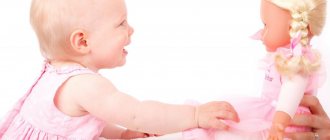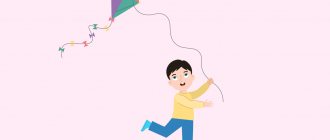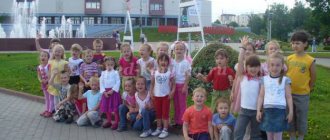Thinking
The accumulation of knowledge does not lead to the development of thinking; it is formed only in active practical and cognitive activity. The development of a preschooler’s thinking goes through 3 stages and represents a complex interrelation of various forms of thinking:
- Visual-effective thinking (3–5 years). The main feature is the inextricable connection of thought processes with practical actions that transform the cognizable object. To think, you need to act with objects. For example, a child spins a toy, presses all the buttons, tries to open it, thus he “experiments and learns with his hands.” In the process of repeated actions with objects (and over a couple of years, hundreds and thousands of different objects will pass through the child’s hands), the child identifies their hidden characteristics and internal connections. Practical actions with objects become a means of understanding reality and form thinking.
- Visual-figurative thinking (4–6 years old) - the child begins to think not with specific objects with the help of his hands, but with their images and ideas, well imagining such objects. The child learns to cognize and solve problems in his mind, relying on his figurative ideas about objects, whereas before this he could only through practical actions. Now, in order for the child to find out which figure fits which hole, he does not need to insert them alternately, he can do this in his mind and quite quickly.
It is worth considering that a child is not always able to come to the correct answer through visual-figurative thinking. His thinking may be strongly influenced by perception. If you show a child two absolutely identical and equal-in-volume balls of dough, and then in front of his eyes, turn one of the balls into a cake and ask where there is more dough, then the child will often declare that the amount of dough in the cake has increased. This thinking error is due to the fact that the child does not yet have the concept of volume and knowledge of other metric measurements. Visual models in which the properties and relationships of objects are reproduced are the most important condition for the formation of internal mental activity.
For the emergence of imaginative thinking, imitation of an adult is also important. By reproducing the actions of an adult, the child builds internal models of actions that he plays out in role-playing games.
3. Logical thinking - begins to take shape towards the end of preschool age (about 7 years) and develops over many years, allowing the child to master the principles of logic. Such thinking is characterized by the fact that as a result the child operates with rather abstract categories and establishes various relationships that are not presented in visual form. However, at first, it is easier for the child to establish cause-and-effect relationships if a specific object is right in front of him and the changes occurring with it can be directly observed. Gradually he moves to thinking that is more abstracted from the current situation.
Children's experimentation
Sometimes another type of child’s thinking is identified - child experimentation. It represents the unity of visual-effective and visual-figurative thinking, and is aimed at knowing the properties and connections of objects.
Such thinking takes the form of experimenting with a phenomenon: the child causes or stops the phenomenon, changes it in one direction or another. In the process of such actions, the child receives new, sometimes unexpected information, which often leads to a change in ideas about the object. For example, a child puts a wooden boat in a stream and sees how it floats, then he takes his toy boat made of iron and sees how it goes to the bottom. The child is perplexed, because both toys are boats that should float, but one drowned. Then the child comes to the conclusion that not every boat is capable of sailing and begins to investigate this issue. In this experimentation, the moment of self-development is clearly presented: the use and transformation of an object/phenomenon reveals its new properties to the child, which, in turn, allow them to make guesses and bring them to life.
Experimentation encourages a child's curiosity and initiative, independence, flexibility of thinking, courage, and stimulates the search for new solutions and creativity. Independent experimentation gives the child the opportunity to try different ways of doing things, while removing the fear of making a mistake (since there is no right option). The ability to be surprised by new things, to make your own guesses, to ask yourself and others questions is more important in the development of thinking than the reproduction of ready-made patterns of action and the assimilation of knowledge given by adults. The role of an adult in this process comes down to creating special objects and situations that stimulate cognitive activity and experimentation.
Questions and answers
At the end of a school lesson or kindergarten class, it is quite appropriate to leave a little time so that children can ask questions that have accumulated and get answers to them. If such work is carried out systematically, the curiosity of the class or group only grows.
A smart teacher responds to questions quickly, but wisely: he answers some immediately, makes others the topic of the next lesson, and for others asks to find the answer in certain books or encyclopedias, and even organizes a competition to see whose answer is better. Independent search for information is absolutely necessary. Of course, in everything a measure is needed so as not to extinguish curiosity and children's interest in an object or phenomenon.
Phenomena of children's thinking by J. Piaget
At first, a child’s thinking is extremely imperfect and its main feature is egocentrism - when the child evaluates any situation only from his own position (point of view). What the child perceives seems to him to be the absolute and only possible option. The reason for this is insufficient separation between the Self and external reality.
An excellent example of egocentrism is the well-known test about brothers, where an adult asks a child:
- You have brothers? - Arthur. - Does he have a brother? - No. – How many brothers do you have in your family? - Two. - How many brothers do you have? - One. - Does he have brothers? - No, absolutely not.
The child does not realize that he may not be the “central” object, and therefore does not realize that his brother has brothers.
Jean Piaget identified other phenomena of children's thinking, which are based on egocentrism:
Animism is the attribution of animation to inanimate objects. Piaget reports the following conversation with a boy:
– Is the sun alive? - Alive. - Why? - It gives light. – Is the candle alive? – Alive, because it gives light. She is alive when she gives light, but not alive when she does not give it.
Artificialism is the understanding of natural phenomena by analogy with human activity or as created by man.
– What does the sun do when there are clouds and rain? – It is leaving due to bad weather. - Why? - Because it doesn't want to get caught in the rain.
Realism is the tendency to consider objects as they appear in their immediate perception. When the moon follows a child while walking, that means it is so. Or a three-year-old child may watch with interest as dad dresses up as Barmaley, but gets scared and cries when the costume and makeup are ready and he sees the terrifying image. Here another feature of children's thinking of this period is manifested: irreversibility, the inability to mentally return to the starting point. In this example, it is impossible to mentally remove the suit and mask from Barmaley and return to the original image of the pope.
Centering is focusing on only one, most noticeable aspect or feature of an object, while ignoring others, i.e. narrowly focused thinking. J. Piaget demonstrated the phenomenon of centering in his experiments on the understanding of conservation. In these experiments, J. Piaget shows that children at the pre-operational stage of thinking development (from 2 to 7 years) do not understand that the important characteristics of objects remain unchanged, despite changes in their appearance. To the problem below, the child will answer: there are more coins in the top row, the top stick is longer, there is more water in one of the glasses, etc. This happens because he is not yet able to correlate several parameters at once - the length of a row of coins with their number, the thickness of sticks with their length, the height and width of glasses with volume.
Conservation tasks developed by J. Piaget Source: [Burke, 2006] With the development of thinking, by the age of 7 the child overcomes egocentrism and most other thinking phenomena, moving to the level of logical thinking.
In general, children's thinking is still far from that of an adult, and it can be difficult for a child to figure out what is reality and what is pretense. For example, can witches really cast a spell on you or that a person can grow wings and fly like in a picture in a book.
Development of cognitive activity in preschool children
The image of the world is formed and exists in the process of origin, development and functioning of the cognitive sphere of a person from the moment of his birth. Any normal child is born with an innate cognitive orientation, which helps him adapt at first to new living conditions. Gradually, cognitive orientation turns into cognitive activity - a state of internal readiness for cognitive activity.
It manifests itself in search actions aimed at obtaining new impressions about the world around us. As the child grows and develops, his cognitive activity increasingly gravitates towards cognitive activity, which, like any activity, is characterized by a certain structure. Its elements (according to A. N. Leontyev) are: the incentive-motivational part (need, motives, goals), the subject of activity, the correspondence of the subject and motive of the activity and the means of its implementation (actions and operations).
According to the authors, the cognitive activity of a preschooler is manifested, first of all, in the child’s ability to accept from an adult and independently set a cognitive task, draw up an action plan, select means and methods for solving it using the most reliable techniques, perform certain actions and operations, obtain results and understand the need to check them. Thus, it turns out that cognitive activity is a volitional, purposeful action, and the process of cognitive activity is determined not by external (motor) activity, not by the child’s degree of employment, but mainly by the level of internal (mental) activity, which carries elements of creativity.
The prerequisite, the physiological basis of cognitive activity is the unconditioned orienting reflex “What is this?” However, this prerequisite can develop into a personality quality called cognitive activity only under certain conditions. The optimal conditions for the formation of this quality should be considered those that ensure, first of all, the formation of motives for educational activities, as well as the quality of knowledge and an emotionally positive background of learning.
The basis of cognitive activity is cognitive interest. Cognitive interest is a form of manifestation of cognitive needs that ensures that the individual is focused on understanding the goals of the activity and thereby promotes orientation, familiarization with new facts, and a more complete and profound reflection of reality.
In general, the cognitive interests of a preschooler child begin to manifest themselves very early. This first manifests itself in the form of children's questions with which the baby besieges parents from the age of 3-4. However, whether such children's curiosity will become a stable cognitive interest or whether it will disappear forever depends on the adults surrounding the child, primarily on his parents. Adults should encourage children's curiosity in every possible way, fostering a love and need for knowledge.
In preschool age, the development of a child’s cognitive interests should proceed in two main directions:
1. Gradually enriching the child’s experience, saturating this experience with new knowledge about various areas of reality. This causes cognitive activity in the preschooler. The more sides of the surrounding reality open to children, the wider the opportunities for the emergence and consolidation of stable cognitive interests in them.
2. Gradual expansion and deepening of cognitive interests within the same sphere of reality.
In order to successfully develop a child’s cognitive interests, parents must know what their child is interested in, and only then influence the formation of his interests. It should be noted that for the emergence of stable interests, it is not enough to simply introduce a child to a new sphere of reality. He should have a positive emotional attitude towards the new. This is facilitated by the inclusion of the preschooler in joint activities with adults.
An adult can ask a child to help him do something or, say, listen to his favorite record with him. The feeling of involvement in the world of adults that arises in the child in such situations creates a positive connotation of his activities and contributes to his interest in this activity. But in these situations, the child’s own creative activity should also be awakened; only then can the desired result be achieved in the development of his cognitive interests and in the assimilation of new knowledge. You need to ask your child questions that encourage active thinking.
A child who has different cognitive interests is characterized by cognitive activity, but its measure and direction are not the same. Therefore, in order to determine the measure of cognitive activity, E.I. Shcherbakova identifies its manifestations in preschoolers in accordance with how the child organizes and regulates the process of his acquaintance with the environment.
She believes that these provisions show: cognitive activity cannot be considered as a volitional, purposeful action, where the goal goes beyond the immediate situation. Shcherbakova E.I. emphasizes that in this case, cognitive activity is the mobilization of intellectual, moral, volitional and physical forces to achieve specific learning goals. She proceeds from the position that activity in the learning process is determined not by motor activity, not by the degree of employment, but by the level of mental activity, which carries elements of creativity.
Shcherbakova E.I. proposed indicators of cognitive activity of preschool children:
1. Passion for studying the material (concentration, attention).
2. A clearly expressed desire to perform a variety of, especially complex tasks.
3. The desire to continue the activity (often such children themselves are the initiators of the game, joint cognitive activity with adults.
4. Demonstration of independence in selecting means, methods of action, achieving results, and exercising control.
5. Use of knowledge in independent activities (game, work, construction).
6. Contacting the teacher with questions aimed at cognitive interest.
7. Quality of knowledge and skills.
In such cases, children achieve the goal not intuitively, but consciously, and are able to explain how they performed the action and why it did so.
To identify and characterize a child’s cognitive activity means to determine its level of development. Godovikova D.B. suggests for this, firstly, to determine the area of objects to which it is aimed (content), and secondly, the nature of the organization of searches.
Godovikova D.B., who believes that cognitive activity is the desire to gain knowledge about the phenomena of the surrounding world, this is both a cognitive need and the cognitive activity stimulated by it. Cognitive activity, in her opinion, has distinct external manifestations, based on which one can judge the nature of its organization.
What a child is interested in, what is the intensity of his desire to get acquainted with certain phenomena, can be judged by 4 indicators:
1. Attention and special interest in subjects;
2. Emotional attitude towards objects (surprise, bewilderment, slyness, that is, a variety of emotions caused by this object);
3. Actions aimed at the recognition devices of an object, understanding its functional purpose. The total number of these actions is evidence of the intensity of the survey. But the quality of actions is especially important, first of all their variety and the replacement of some types by others, pauses during which the child thinks about this subject.
4. Constant desire for an object, even when it is not there.
Thus, Godovikova D.B. Identifies manifestations of cognitive activity in accordance with how the child carries out the process of his acquaintance with the environment, which, in her opinion, indicates a readiness to overcome difficulties and obstacles on the way to recognizing the essence of the subject.
Thus, cognitive activity during preschool age goes through a complex path of development from simple orientations, which are caused by the novelty of the subject, to the desire to resolve the contradiction between established knowledge and skills that arise in the process of children’s activities.
In order to develop cognitive activity, a child will ideally need to determine typical attitudes - the development of knowledge and cognitive schemes; protecting existing knowledge and cognitive schemas; degree of inclusion in educational activities/
In preschool pedagogy, cognitive activity has been repeatedly considered from the point of view of cognitive interest (Nechaeva V.G., Zakharevich L.F., Manevscheva M.M., Postnikova N.K.) and mathematical abilities (Krutetsky V.A.) or the development of thinking (Poddyakov N.I., Proskurova E.V.), quality of learning in general (Nepomnyashchaya N.I., Vyatkina L.A., Gracheva Z.A.).
There is another approach to determining the manifestations of cognitive activity. E.I. Shcherbakova, based on psychological and pedagogical literature, and more specifically, approaches to the problem of optimizing the cognitive activity of students (Yu.K. Babansky, M.A. Danilov, I.Ya. Lerner, T.I. Shamova, etc.) identifies the following manifestations of cognitive activities:
1. The ability to see and independently set a cognitive task.
2. Draw up a plan and select ways to solve the problem using the most reliable and effective techniques.
3. Achieve results and understand the need to verify them.
Thus, E.I. Shcherbakova identifies manifestations of cognitive activity in accordance with how the child organizes and regulates the process of his acquaintance with the environment. She believes that these provisions show: cognitive activity cannot be considered as a volitional, purposeful action, where the goal goes beyond the immediate situation. E. Shcherbakova emphasizes that in this case, cognitive activity is the mobilization of intellectual, moral-volitional and physical forces to achieve specific learning goals. She proceeds from the position that activity in the learning process is determined not by motor activity, not by the degree of employment, but by the level of mental activity, which carries elements of creativity.
Such a variety of approaches to determining the essence and content of cognitive activity causes some difficulty in accurately isolating it from the child’s general activity. It is known that cognitive activity begins with living contemplation in a broad sense - with sensations and perception. Thus, in teaching children the elements of mathematics, this is associated with specific practical and cognitive actions: children observe, listen, examine, apply, apply, count, measure, etc.
Already this stage of learning is characterized by activity. However, in these cases, relying on the position of E.I. Shcherbakova, it would be more correct to talk about general mental activity. VC. Kotyrlo and T.V. Dutkevich proposes to judge the cognitive activity of children by their ability to transform the situation, which is expressed in the fact that in older preschoolers the “reaction to novelty” develops greatly, it turns into the ability to see and note the known and the unknown, the known and the new, the ordinary and the unusual. VC. Kotyrlo and T.V. Dutkevich note that children with different cognitive activity can qualify the same situation as familiar or highlight the specifics of its specific conditions.
They emphasize that even under normal conditions, a cognitively active child, thanks to his imagination and interest, transforms the environment, revealing its new sides and nuances, enriching his cognitive experience. Transformations are expressed in changing the conditions of the situation, introducing new elements and finding their new combinations or unusual possibilities of functioning.
This rather important indicator of cognitive activity should be taken into account along with the indicators of cognitive activity proposed by E.I. Shcherbakova:
1. Passion for studying the material (concentration, attention).
2. A clearly expressed desire to perform a variety of, especially complex tasks.
3. The desire to continue the activity (often such children themselves are the initiators of games and joint cognitive activities with adults).
4. Demonstration of independence in selecting means, methods of action, achieving results, and exercising control.
5. Use of knowledge in independent activities (play, work, constructive)
6. Contacting the teacher with questions aimed at cognitive interests.
7. Quality of knowledge and skills. In such cases, children achieve the goal not intuitively, but consciously, and are able to explain how they performed the action and why it did so.
Researchers note that every child is characterized by cognitive activity, but its measure and direction are not the same. To identify and characterize a child’s cognitive activity means to determine its level of development. D.B. Godovikova proposes to do this, firstly, to determine the area of objects to which it is directed (content), and secondly, the nature of the organization of the child’s search activity in a difficult cognitive situation for him.
Based on this, D.B Godovikova identifies three levels of cognitive activity:
1. Children strive for toys that have bright perceptual properties (large, colorful, sonorous), as well as those that are familiar in their functional purpose (telephone, dishes, etc.); there is no interest in objects of unclear purpose. Search regulation is external; objects dominate activity (the level of interest in the external properties of an object is determined by the object itself).
2. Its essence is the content of the cognitive need and the level of self-organization. Children strive to become familiar with toys and other objects that have certain functions. The possibility of using them in different ways and testing their functional properties is attractive; the desire to penetrate into the hidden properties of an object is expressed. However, the regulation of search is subject to emotions (the level of interest in the functional qualities of an object and the regulation of search are determined with the help of an adult).
3. Its essence is new content. Interest and activity are aroused by the hidden, internal properties of an object, the so-called secrets, and to a greater extent by internal, conceptual formations. Activity is guided by the goal of achieving the desired result. The goal may not be achieved, but the desire for success remains for a long time. Behavior is guided by one's own intention.
The combination of all signs of behavior is not always so clearly uniform, emphasizes D.B. Godovikov, but characteristic and stable enough to serve as the norm.
Thus, cognitive activity during preschool age goes through a complex path of development from simple indicative reactions that are caused by the novelty of the subject, to the desire to resolve the contradictions between existing knowledge and new cognitive tasks that arise in the practical activities of children.
What factors ensure the transition from one level of development of cognitive activity to a higher one, what is the source of the formation and manifestation of cognitive activity? Modern studies studying the characteristics of cognitive activity do not give a clear answer to this question.
M.S. Yakimansky believes that cognitive activity depends on the experience of the child himself, which provides him not only with the conscious assimilation of new material, but also with its transformation.
P.A. Pobirchenko draws attention to the fact that activity is especially noticeable when there is an opportunity to explore, transform, engage in new connections and relationships, pose new problems, and discover new things.
L.I. Bozovic notes that one cannot expect activity in a child who is deprived of independence.
A.M. Matyushkin believes that the basis for the development of cognitive activity is those principles of personality education and the development of thinking, which include stimulation and encouragement of the very acts of cognitive activity on the part of another person. That is why, according to A.M. Matyushkin, the most significant situations in the occurrence of acts of cognitive activity are situations of communication, various types of interpersonal interaction, games, and learning. Thus, he assigns decisive importance in the development of cognitive activity to the leading type of activity and communication with adults.
From the point of view of M.I. Lisina, the main factor in the development and formation of cognitive activity should be considered the communication of a child with an adult, during which the child learns, on the one hand, an active and interested attitude towards phenomena and objects, on the other hand, ways to manage his behavior, overcomes the difficulties of orientation in new situations.
E.I. Shcherbakova points out that the prerequisite, the physiological basis of cognitive activity is the orienting reflex “What is this?” But this prerequisite can develop into a quality called cognitive activity only under favorable conditions. The main task of pedagogy, in her opinion, is to create such conditions.
Conditions conducive to the activation and development of cognitive activity, proposed by T.I. Babaeva, in our opinion, generally take into account the characteristics of the cognitive activity of preschool children:
1. The development of cognitive activity is facilitated by such an organization of learning in which the child is involved in the process of independent search and discovery of new knowledge and solving problems of a problematic nature.
2. The child’s intellectual and practical activities in the classroom should be varied. The monotony of information and methods of action quickly causes boredom and reduces activity.
3. It is necessary to constantly change the forms of questions and tasks, stimulate the search activity of children, creating an atmosphere of intense teamwork.
4. The content of the classes should be difficult, but feasible. Material that is too simple or complex does not arouse interest, does not create the joy of intellectual victory, problem solving, or supporting cognitive activity.
5. The more new material is related to the existing experience of preschoolers, the more interesting it is for them.
6. The teacher’s emotionality, his ability to support and direct interest in the content of the lesson stimulates the cognitive activity of children.
Thus, we see that cognitive activity is formed mainly in cognitive activity, which is associated with the purposeful actions of children. Pedagogically correctly organized activities contribute most effectively to its formation. N.N. Poddyakov believes that the basis of such activity should be the provision that, simultaneously with the formation of clear, distinct knowledge, there remains a zone of uncertain knowledge, appearing in the form of guesses, assumptions, and questions from children, so that satisfaction with the new acquired knowledge at the end of the next lesson is combined with the impatience to learn that The next one will be so that children do not wait for explanations from adults, but rather clarify what is unclear to them, make predictions, and make guesses.
It is this peculiar problem in the form of uncertainty of knowledge that is a powerful stimulus for children’s cognitive activity. Based on this situation, in the mid-80s a basic strategy for problem-based learning for preschool children was developed. Research by A.V. Zaporozhets, A.N. Leontyeva, L.A. Venger, N.N. Poddyakov convincingly reveal that problem-based learning should be built as an independent creative search, only then learning is not a reproductive, but a creative activity, then it contains everything that can captivate, interest, and awaken a thirst for knowledge. At the same time, being formed in the process of activity, cognitive activity at the same time affects the quality of this activity, acting as a means and condition for achieving the goal.
Cognition is the process of reflecting and reproducing reality in human thinking, conditioned by the development of social historical practice. The result of which is new knowledge about the world. Specially organized cognition constitutes the essence of the educational process.
Mental development is a complex dynamic system of quantitative and qualitative changes that occur in a person’s intellectual activity as a result of his mastering experiences that correspond to the social and rhetorical conditions in which he lives, the age and individual characteristics of his psyche.
Abilities are individual psychological characteristics of a person, which are a condition for the successful implementation of one or another productive activity.
The cognitive development of a preschooler implies mastery of the means of cognition, mastery of means and methods of describing the world around him, the development of intellectual emotions, familiarity with various spheres of reality, the expansion of cognitive activity and independence.
Means of cognition - standards, models, speech, etc.
Methods of cognition - observation, examination, comparison, classification, seriation, analysis, synthesis, inference, evaluation, experimentation.
The concepts of curiosity and cognitive interest have a common basis - a cognitive attitude towards the environment. Differences in the volume and depth of this relationship, in the degree of activity and independence
Curiosity is the general direction of a positive attitude towards a wide range of phenomena.
Cognitive interest is manifested in the desire to find out what is unclear about objects and phenomena, in the desire to delve into the essence, to find connections and relationships. The basis of cognitive interests is active mental activity.
Cognitive interest differs from curiosity in its breadth of coverage of objects, depth of knowledge, and selectivity. Reflected in drawings, stories, games and other types of creative activities.
Cognitive interest is most often directed at a certain aspect of life, at one or another phenomenon or object. Cognitive interest includes intellectual activity in combination with an emotional attitude and volitional efforts. Characteristic features of cognitive interest: versatility, depth, stability, dynamism, effectiveness.
Cognitive activity is an active state of the individual, which is characterized by the desire to learn, mental stress and the manifestation of volitional efforts in the process of acquiring knowledge. 3 levels – reproducing, interpreting, creative.






